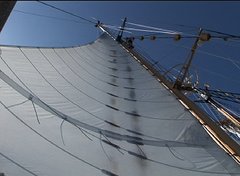 |
A local
fisherman paddles out past the forereef on Fanning
|
Fanning is our last port stop before the end of our journey in Hawaii. In some ways, it feels unfathomable that this could be the case, but in other ways we feel as if we’ve been at sea forever. There’s so much more to be done, but so much has already happened.
We’ve progressed since our first port stop at Rangiroa: as sailors, as a community and as a research vessel. We’ve traveled over 1700 nautical miles, crossed the equator and deployed science gear at 28 distinct sites. Setting and striking sails is no longer a mysterious process—we know our halyards from our braces, brailles, outhauls, inhalls, downhalls, jiggers, and topping lifts. We’ve shared so many stories, songs, and sunsets with our shipmates that’s it’s hard to remember a time when we didn’t know each other or a day that didn’t end with a spectacular show.
 |
| The start of a typical snorkel mission |
Along the way, we’ve visited some pretty spectacular places. I’m struggling to articulate what it’s like to come to the places we’ve been—there’s so much to say about each island, but it’s hard to describe somewhere unlike any place you’ve ever been. With that in mind, I’ll try my best to convey what it feels like.
If I had to pick a single adjective to describe these islands, I’d choose “improbable.” These are places that most people will never know the name of, let alone visit or see. If you threw a dart at a chart of the Pacific Ocean, you’d never hit Rangiroa, Caroline, Malden, Christmas or Fanning. The highest point of each island is often whatever tree grows the tallest. This means that even as you approach them, the islands are so low that if you didn’t already know where they were, you might not notice them until you were right on top of them.
But here we are, anchored next to a pinprick of green amidst the endless blue. How strange and wonderful that is! Looking out at Fanning, one feels as if transported to an elaborate movie set. The thickness of palm trees, the breaking waves… it’s picturesque to the point that you feel as if you’re looking at a watercolor painted by someone who’s only ever heard fanciful descriptions of islands.
Like all of our port stops so far, Fanning is a coral atoll, a ring of coral growth around an ancient volcano. It’s a low island with a large lagoon connected to the ocean by one big channel and a few smaller ones. Underwater, the island drops off very quickly, sloping far more steeply than any terrestrial mountain. Water rips in and out of the lagoon through the main channel, knurling the surface and creating standing waves. Large waves curl and break along the island, exploding into spray wherever the coral reaches close to the surface. The beach is picturesque from afar, but it’s very thin and actually comprised of unfriendly large coral hunks. Like Caroline, Fanning is densely carpeted with vegetation. Much of it is coconut trees, left over from the days when Fanning was used for copra production. It’s a layered appearance, blue sky over a strip of green, white beach and bright blue water.
Fanning is inhabited, though only sparsely: fewer than 4000 people, according to a local resident. In the village, there are no stores and no cars. This is, by far, the most remote inhabited island that we’ve visited. Unlike Christmas and Rangiroa, there is no airport to the outside world and no hotels designed to accommodate foreigners. There are customs officials, however. I guess some things are universal.
The coral on the part of the forereef that we visited was the largest I’ve seen, though it seems like a storm has come through recently because many of the tabletop corals are toppled or broken into pieces. The fish swim about, hiding in the coral spaces. Here, we’ve seen parrotfish, Picasso triggerfish, surgeonfish, snappers, jacks, and wrasse. From the ship, we’ve caught a small yellowfin tuna, a skipjack tuna, a trevally, and a wahoo.
 |
| A colorful Pacific sunset from the pier at Rangiroa |
Soon we will once more be surrounded by the vast Pacific, but for now, the world is much smaller, confined to this little ring of coral.
Happy week nine!
-Sam


5 comments:
Just beautiful, Sam - you're all such amazing writers. Such an improbable journey as they one you've all had is on the top of my bucket list now!
Great to hear from you Sam! Enjoyed every detail of your post and can hardly wait to hear many more stories when we see you. Fair winds and weather all the way to Hawaii! PS - What is the ITCZ??
Sam, I look forward to hearing you swap sea stories with your Uncle. Fair winds, clear skies and fine seas to you and your mates!
Thanks for the wonderful insight, Sam! Please keep the blog posts coming for those of us who are experiencing this magical adventure vicariously...
HI SAM!!!!!!!!! WE MISS YOUUUUU -Meredith Ned and Vikram
PS. downhaul*
Post a Comment